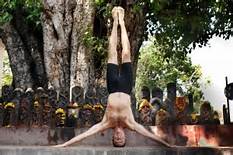When David Swenson’s name popped up in an email from Triyoga in London, promising teaching on the FUNdamentals of ashtanga, I decided to treat myself to one of the sessions last Sunday. The class that appealed most was ‘Half and half and twice the fun’ – half primary followed by half intermediate. I enjoy this kind of practice and wanted to experience how David would approach it.
He began with a quick talk on how Guruji taught him the sequence – full primary with intermediate poses added on afterwards, making for a longer and longer practice. He thought Guruji’s strategy here was to keep adding postures until students couldn’t take any more, and stopped of their own accord.
It makes a lot of sense for students to find their own stopping point. It’s empowering and helps us get to know ourselves. David said he would teach us in that way, taking us through intermediate until he saw a collective look of desperation that said ‘enough!’
As we launched into intermediate after navasana, the energy in the room picked up and David’s sense of humour started bouncing off it. His stories and images seemed to get more off-the-wall with every pose.
The yogi’s dream
For example, after we finished at eka pada sirsasana, he went through the rest of intermediate in a story form. The yogi asleep in yoga nidrasana dreams of mad insects (titibhasana), stinging a peacock (pincha mayurasana), the sight of which causes a crocodile to come out of the river (nakrasana) and scare a horse (vatyanasana) which rears up, gallops through a gate (parighasana) and jumps onto a cow (gomukhasana).
To express awe at such a turn of events, the yogi then just has to do seven headstands. It’s the only possible response.
This dramatic, surreal story captured the energy of intermediate – it gave us a real sense of these poses while we just sat back and laughed.
A room of bouncing crocodiles
David then managed to top the surrealism by getting the whole room trying nakrasana. If there are even two people in a room doing nakrasana at the same time, it’s impossible not to laugh – so you can imagine what it’s like when 40-odd are doing it. ‘Get really good at this and someone can ride on your back,’ said David. ‘Some teachers even like to enter the room that way.’
Five things I learned from David’s class
- You can learn intermediate when you can practise primary with ‘awareness, presence and rhythm’. Binding in marichasana D and dropping back/standing up unassisted aren’t criteria for him.
- Laghu vajrasana was originally taught with the hands placed on the front of the thighs, fingers pointing towards each other.
- To get up from laghu vajrasana and kapotasana, think of James Brown performing and how he gets up from the splits: a slight shuffle inwards, a scoop up, and ‘I feel good!’
- Three strikes and you’re out: have a go at a pose a maximum of three times before moving on.
- Good teachers know the difference between the unexplained emotional release that comes with practising intermediate and emotional pain that has a cause. Guruji wouldn’t dwell too much on practice-induced emotional release, but was very caring about emotional pain caused by something happening in a student’s life. He knew the difference straight away.


No comments yet.